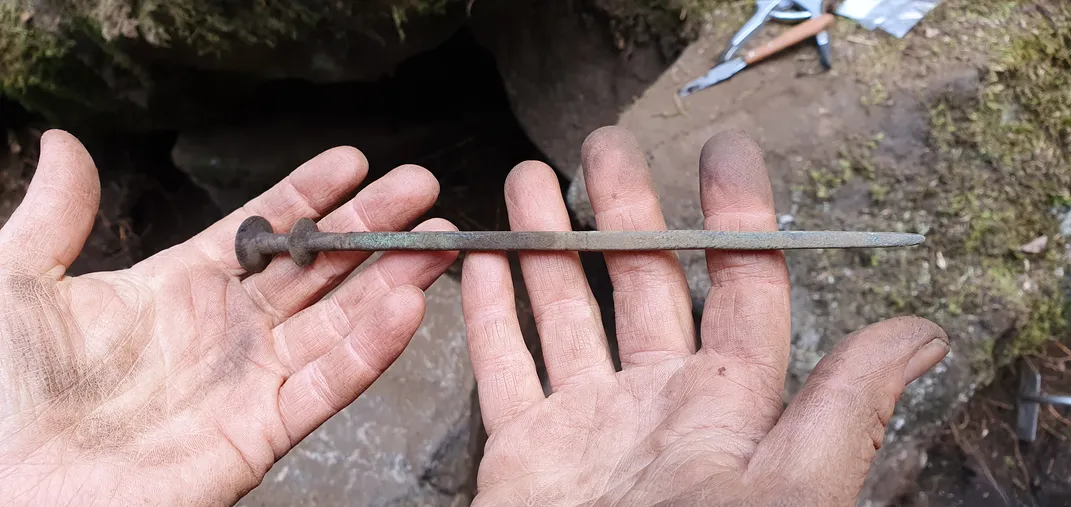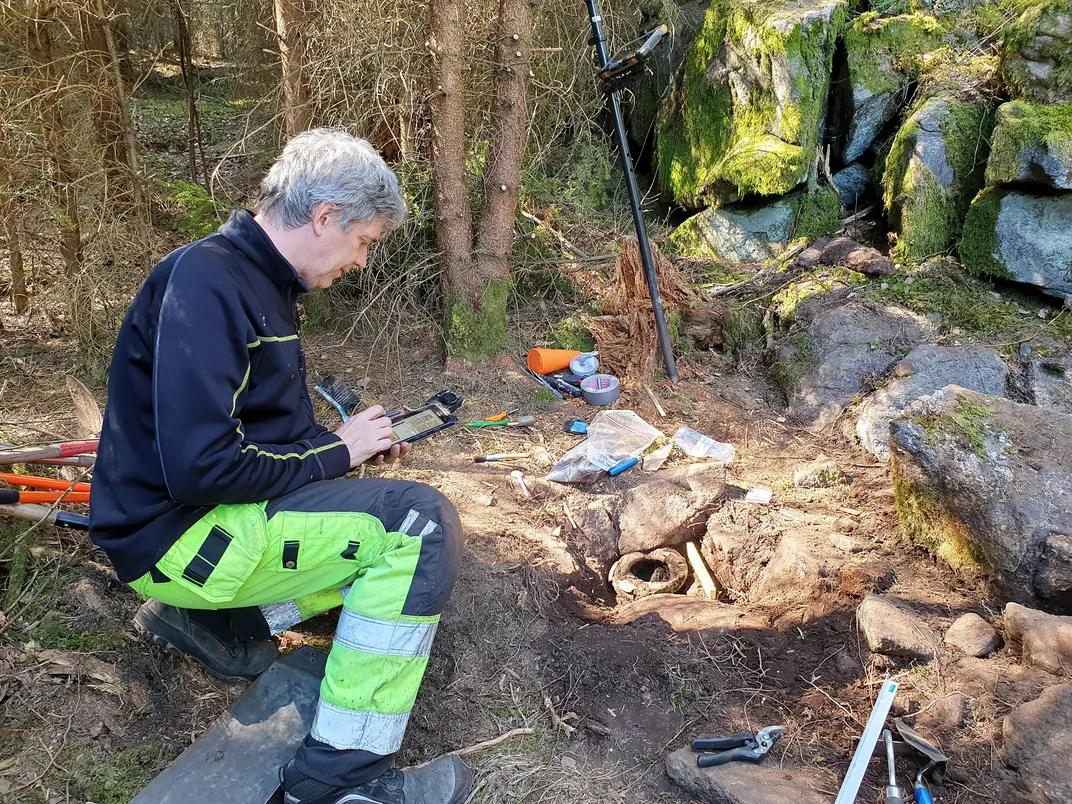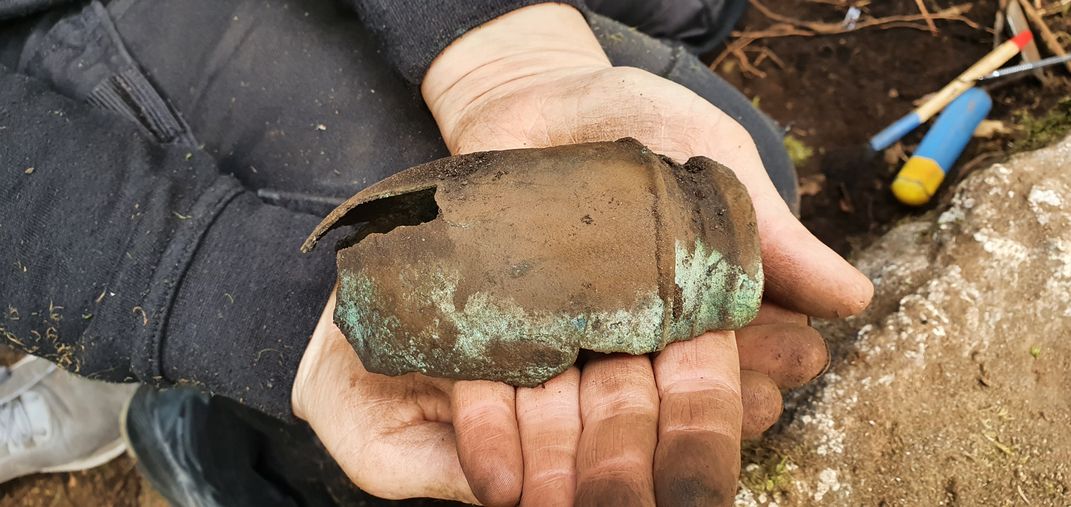Swedish Man Discovers Trove of Bronze Age Treasures Hidden in Plain Sight
A high-status woman once adorned herself with these items, which a local found buried beneath the forest floor
:focal(2828x2142:2829x2143)/https://tf-cmsv2-smithsonianmag-media.s3.amazonaws.com/filer/b0/8a/b08aafa3-3589-432c-95f0-9327e67aa3db/5_del_av_halsring_foto_mikael_agaton.jpg)
In early April, mapmaking enthusiast Tomas Karlsson was exploring a forest outside the small western town of Alingsås, Sweden, when he noticed a gleam of metal on the mossy forest floor.
“It looked like … garbage,” Karlsson, who made the find while updating a map for his orienteering club, tells Swedish newspaper Dagens Nyheter, per a translation by Agence France-Presse (AFP). “‘Is that a lamp lying here?’ I thought at first.”
What initially resembled bits of scrap metal turned out to be a small pile of handmade jewelry that appears to have been scraped loose from between two boulders by an animal. Intrigued, reports Mia Pettersson for Swedish newspaper Göteborgs-Posten, Karlsson emailed an archaeologist about the discovery while paused for a coffee break.
Soon after, researchers from the nearby University of Gothenburg revealed the fantastic nature of Karlsson’s accidental find: He had unwittingly happened upon a deposit of about 80 rare Bronze Age artifacts (including 50 wholly intact pieces and 30 fragments) dated to between 750 and 500 B.C.
As a local government statement notes, per Google Translate, the extraordinary trove is “very well preserved” and amounts to one of the “most spectacular and largest depot finds from the Late Bronze Age ever made, not only in western Sweden but in all of Sweden.”
Archaeologist Johan Ling led a team of researchers that used metal detectors and laser scanning techniques to determine the full extent of the buried treasure. A separate university statement notes that the items were likely deposited by a very rich person or family.
“This may have been in connection with a burial in order to facilitate their use in the afterlife,” says Ling in the statement, per a translation by Phys.org. “But more likely [it was] a way of signaling their status: ‘I can afford to sacrifice some of my affluence.’”
Scholars surveying the cache identified an intricate spiral-shaped buckle, necklaces, bronze needles, a tutulus (or type of dress ornament), bracelets, a hollow ax, items used in wax bronze casting, and jewelry that would have adorned women’s heads and ankles more than two millennia ago. Researchers also discovered a rod used to spur on horses—a distinctive instrument previously found in Denmark, but never in Sweden, according to BBC News.
A high-status woman living during the late Nordic Bronze Age likely used most of these items to adorn herself and secure articles of wool clothing, Ling adds. As the National Museum of Denmark notes, the Bronze Age in this part of the world generally refers to 1700 to 500 B.C., a period when bronze and gold metalworking abounded and domestic horses were introduced to the region.
Government officials announced the find, which took place on April 8, at a digital press conference last Thursday. Researchers are currently examining the deposit site and working to conserve the artifacts. They hope to eventually display some of the cache in a museum, report Anita Nilsson and Zara Tellander for local news site VGRfokus.
“All the artifacts were essentially intact,” says Madelene Skogberg, a conservator at the local Cultural Affairs Committee, in the university statement. “For them to be so well preserved is unique, and it is likely they would have remained there unless an animal had decided to build its nest there.”
As Pernilla Morner, antiquarian at the County Administrative Board of Västra Götaland, adds in the government statement, “Not since the bronze shields from Fröslunda were excavated from a field in Skaraborg in the mid-1980s has such an exciting find from the Bronze Age been made in Sweden.”
For archaeologists and amateurs alike, the surprise discovery provided a rare thrill.
“It was cool to see how the archaeologists reacted when they saw the things. For them, this is also once in a lifetime,” Karlsson tells Göteborgs-Posten, as translated via Google Translate.
“It is something you’ve dreamed of since you were a child, to find a treasure like this,” he adds.
Per BBC News, Swedish law requires anyone who discovers antiquities to turn their findings over to the state. The Swedish National Heritage Board will assess the cache’s value—and possibly offer Karlsson a monetary reward.
“It would be a nice bonus but is not very important to me,” Karlsson says to Göteborgs-Posten. “It’s fun to be a part of exploring history. We know so little about this era because there are no written sources.”
/https://tf-cmsv2-smithsonianmag-media.s3.amazonaws.com/accounts/headshot/nora.png)

/https://tf-cmsv2-smithsonianmag-media.s3.amazonaws.com/filer/80/b9/80b9355f-de67-4559-be43-80c8ec87552a/6_spiral_i_pase_glasogonformat_spanne_foto_mikael_agaton.jpg)


/https://tf-cmsv2-smithsonianmag-media.s3.amazonaws.com/filer/a4/0e/a40e0956-6130-4808-8711-0bf17494a90a/10_wulstring_upplockad_fotring_foto_mats_hellgren.jpg)
/https://tf-cmsv2-smithsonianmag-media.s3.amazonaws.com/accounts/headshot/nora.png)